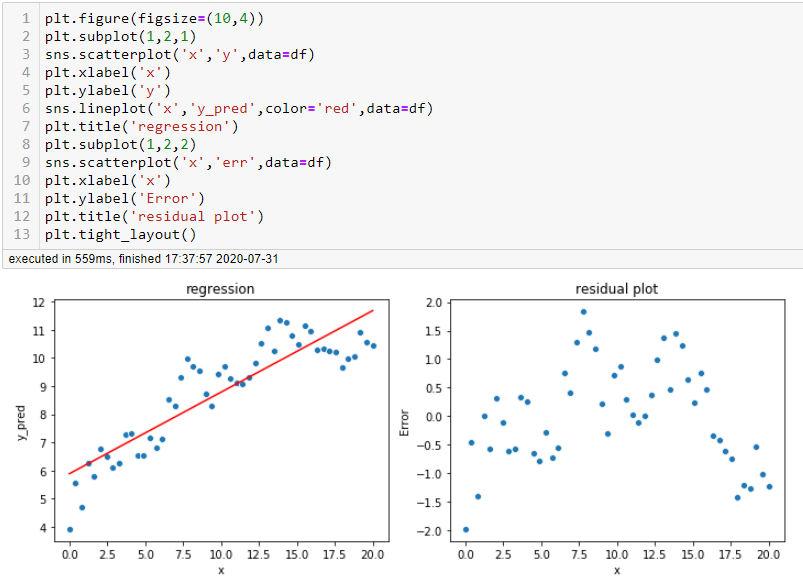

Data from example 5-1 in Fogler, Elements of Chemical Reaction Engineering. Matlab post Fit a fourth order polynomial to this data and determine the confidence interval for each parameter. Or if the breaks above the downtrend line drawn with the higher points, it can be thought of as a price pivot to bullish. from scipy import linspace, polyval, polyfit, sqrt, stats, randn from matplotlib.pyplot import plot, title, show, legend Linear regression example This is a very simple example of using two scipy tools for linear regression, polyfit and stats.linregress Sample data creation number of points n 50 t linspace(-5,5,n) parameters a. Linear regression with confidence intervals.
SCIPY STATS LINREGRESS CODE
Arguments: x: x data: y: y data: Returns: m, c, nan, nan, nan Uses standard ordinary least squares to estimate the starting parameters: then uses the scipy.odr interface to the ODRPACK Fortran code to do the: orthogonal distance calculations. When the current price hits the downtrend line, the price curve might be rebounced within the trend. using the same interface as the standard function. Now that the data is ready, we can call the () function and perform linear regression. Now if we have 2 higher price points in a chart and we draw a trend line by connecting 2 points. Or if the price breaks under the uptrend line drawn with the lower points, it can be thought of as a price pivot to bearlish. Consider the following example from the docs: > from scipy import stats > import numpy as np > x np.random.random (10) > y np.random.random (10) > slope, intercept, rvalue, pvalue, stderr stats.linregress (x,y) > pvalue 0.

When the current price hits this uptrend line, the price curve might be rebounced within the trend. returns a p-value corresponding to the slope, but no p-value for the intercept. Let’s assume we have 2 lower price points in a chart and draw a trend line. So it can be employed to know these 2 points in a chart. Here we will use the above example and introduce you more ways to do it.

For example, we can use packages as numpy, scipy, statsmodels, sklearn and so on to get a least square solution. When you take lower points in a trend, a trend like acts like a support line while taken higher points can act like a resistence line in a trend. In Python, there are many different ways to conduct the least square regression. I have a weird situation with seems to be returning an incorrect standard error: from scipy import stats x 5.05, 6.75, 3.21, 2.66 y 1.65. The usual practice in machine learning is the opposite: rows are observations and columns are features. During the analyzed timeframe, analysts take at least 2 points in a chart to connect those points to draw a straight line. Note: In the example above, () considers the rows as features and columns as observations.

Trandline’s vidualization is recognizable for traders to know a direction of trend and patterns of price bounces. linregress ( t, xn ) print ( 'Linear regression using stats.linregress' ) print ( 'parameters: a= %.2f b= %.2f \n regression: a= %.2f b= %.2f, std error= %.3f ' % ( a, b, a_s, b_s, stderr )) print ( ' \n ' ) # matplotlib ploting title ( 'Linear Regression Example' ) plot ( t, x, 'g.-' ) plot ( t, xn, 'k.' ) plot ( t, xr, 'r.A trendline is a line drawn over pivot highs or under pivot lows to show the prevailing direction of price.Ī trend line is one of important tools for technical traders. From scipy import linspace, polyval, polyfit, sqrt, stats, randn from matplotlib.pyplot import plot, title, show, legend # Linear regression example # This is a very simple example of using two scipy tools # for linear regression, polyfit and stats.linregress # Sample data creation # number of points n = 50 t = linspace ( - 5, 5, n ) # parameters a = 0.8 b = - 4 x = polyval (, t ) # add some noise xn = x + randn ( n ) # Linear regressison -polyfit - polyfit can be used other orders polys ( ar, br ) = polyfit ( t, xn, 1 ) xr = polyval (, t ) # compute the mean square error err = sqrt ( sum (( xr - xn ) ** 2 ) / n ) print ( 'Linear regression using polyfit' ) print ( 'parameters: a= %.2f b= %.2f \n regression: a= %.2f b= %.2f, ms error= %.3f ' % ( a, b, ar, br, err )) print ( ' \n ' ) # Linear regression using stats.linregress ( a_s, b_s, r, tt, stderr ) = stats. Kita juga bisa menggukanan fungsi () yang akan menghasilkan beberapa nilai, salah satunya adalah koefisien korelasinya: > (x, y) LinregressResult(slope0.5181818181818181, intercept5.714285714285714, rvalue0.861950005631606, pvalue5.122760847201164e-07, stderr0.


 0 kommentar(er)
0 kommentar(er)
